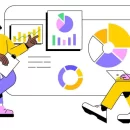Clinical trials play a crucial role in advancing medical research and development, but one persistent challenge researchers face is recruiting and retaining adequate participants. Ineffective recruitment strategies can significantly delay trials, impeding scientific progress. However, clinical trial consulting can help. By leveraging the patient mapping approach, clinical trial recruitment can become more efficient, reducing delays and expediting the advancement of medical research. Additionally, by employing workflow mapping techniques, researchers can optimize the recruitment process and enhance the efficiency of physical or virtual clinical trials. This blog post delves into the benefits of workflow mapping and how it can revolutionize recruitment in clinical trials.
Understanding workflow mapping
Workflow mapping is a systematic approach that visualizes a process’s sequential steps and activities. By diagramming the process, workflow mapping enables stakeholders to identify bottlenecks, inefficiencies, and areas for improvement. In clinical trial recruitment, workflow mapping provides a comprehensive overview of the recruitment process, facilitating a clear understanding of its intricacies.
Mapping the recruitment process
The first step is to map out the entire workflow to improve the recruitment process in clinical trials. Begin by identifying the key stages of your virtual clinical trials and activities involved: advertising, participant screening, informed consent, enrollment, and follow-up. Each stage can be further broken down into smaller subtasks and subprocesses. Mapping these steps visually using flowcharts or process diagrams helps stakeholders gain a holistic view of the recruitment process.
Identifying inefficiencies
Once the recruitment workflow is mapped, it becomes easier to identify inefficiencies or roadblocks that hinder the smooth progression of the process. Common challenges in clinical trial recruitment include low awareness among potential participants, excessive paperwork, lengthy screening processes, and poor communication between stakeholders. Examining the mapped workflow makes these inefficiencies evident, enabling researchers to target specific areas for improvement.
Streamlining the recruitment process
Workflow mapping empowers researchers to optimize recruitment by streamlining and simplifying each stage. Suppose participant screening is identified as a bottleneck. In that case, the process can be reevaluated to determine if specific criteria can be modified or eliminated to increase the pool of eligible participants. Similarly, cumbersome paperwork can be reduced by digitizing consent forms and other documents. Efficient communication channels can be established between research teams, potential participants, and referring physicians to minimize delays and improve information flow.
Enhancing participant engagement
Engaging potential participants is crucial for successful recruitment in clinical trials. Workflow mapping can help researchers identify opportunities to enhance participant engagement throughout the process. Researchers can tailor their communication and engagement strategies by understanding the participant’s journey. For instance, digital platforms and mobile apps can facilitate information exchange, reminders, and updates, making it easier for participants to remain engaged and committed to the trial.
Monitoring and continuous improvement
Workflow mapping improves the recruitment process and allows for ongoing monitoring and continuous improvement. By tracking the progress of the mapped workflow and collecting relevant data, researchers can identify patterns, measure performance, and make data-driven decisions. Regular review and refinement of the recruitment process based on these insights can ensure sustained improvement, leading to more efficient and timely clinical trials.
The recruitment process in clinical trials is often complex and challenging. However, workflow mapping provides a powerful tool for researchers to identify inefficiencies, streamline processes, and enhance participant engagement.








